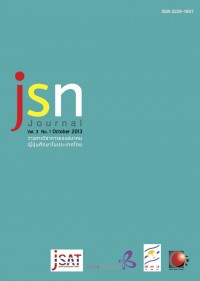บทบาทหน้าที่ของสัตว์ในบทกลอนญี่ปุ่น เฮียะกุนินอิฌฌุ
Main Article Content
Abstract
บทกลอนใน เฮียะกุนินอิฌฌุ มีสัตว์หลายชนิดปรากฏอยู่ บทความวิจัยนี้มีวัตถุประสงค์เพื่อวิเคราะห์บทบาทหน้าที่ของสัตว์ ที่ปรากฏอยู่ในบทกลอน เฮียะกุนินอิฌฌุ โดยเฉพาะอย่างยิ่งการใช้ สัตว์เพื่อสื่ออารมณ์ความรู้สึก จากการศึกษาพบว่า สัตว์ในบทกลอน เฮียะกุนินอิฌฌุ ถูกใช้เพื่อสื่อถึงสิ่งต่างๆ เช่น อารมณ์ความรู้สึกของ กวี ตำนานโบราณ หรือใช้ช่วยสื่อภาพในความเปรียบ นอกจากนี้เสียง ร้องของสัตว์ที่ปรากฏในบทกลอน เฮียะกุนินอิฌฌุ ยังช่วยสื่ออารมณ์ อันเศร้าสร้อยหรือความเงียบเหงาเปล่าเปลี่ยวของกวีด้วย
The Role of Animals in Japanese Poems in Hyakunin’isshu
Attaya Suwanrada
Faculty of Arts, Chulalongkorn University
Hyakunin’isshu is a classical Japanese anthology edited in 1235 by Fujiwara no Sadaie, usually called as Teika. Teika selected one hundred Japanese poems composed by one hundred famous poets, one poem each. These poets were alive between the 7th -13th century. Hyakunin’isshu is admired to be a fundamental textbook for composing Japanese Tanka and is also well-known since the poems in Hyakunin’isshu appear on Japanese cards, Karuta.
Many kinds of animals appear in Hyakunin’isshu. This article aims to study the role of animals in Hyakunin’isshu especially using animal to express emotion or feelings. The research finds that animals in Hyakunin’isshu are used to express many things such as the poets’ emotion, old tales and also help accentuate image in figurative expression. Furthermore, voice of animals in Hyakunin’isshu helps to express sadness or loneliness of the poets.
Article Details
ข้อความและข้อคิดเห็นต่างๆ ในบทความเป็นของผู้เขียนบทความนั้นๆ ไม่ใช่ความเห็นของกองบรรณาธิการหรือของวารสาร jsn Journal


